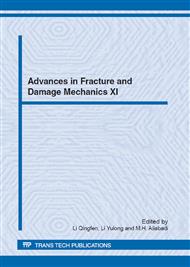p.417
p.421
p.425
p.429
p.433
p.437
p.441
p.445
p.449
Damage Detection for Structural Health Monitoring Using Ultrasonic Guided Waves
Abstract:
The use of ultrasonic guided waves for damage detection suffers from the multi-modes and dispersion. Much attention has been paid to transducer design and excitation frequency chosen to suppress the multiple modes and dispersion. However, little attention has been paid to complex signal processing. In this paper, the dispersive propagation of the guided waves are firstly reviewed. And then the matching pursuit method is introduced as a feature extraction algorithm. In order to present well the characteristic of the guided waves signal, a dispersive dictionary is designed based on the guided waves propagation. A two-stage pursuit method consisted of coarse and fine matching is used. At last, the proposed method is verified by finite element simulation and successfully extracted damage related dispersive pulses from measured noisy signal.
Info:
Periodical:
Pages:
433-436
Citation:
Online since:
November 2012
Authors:
Keywords:
Price:
Сopyright:
© 2013 Trans Tech Publications Ltd. All Rights Reserved
Share:
Citation:


